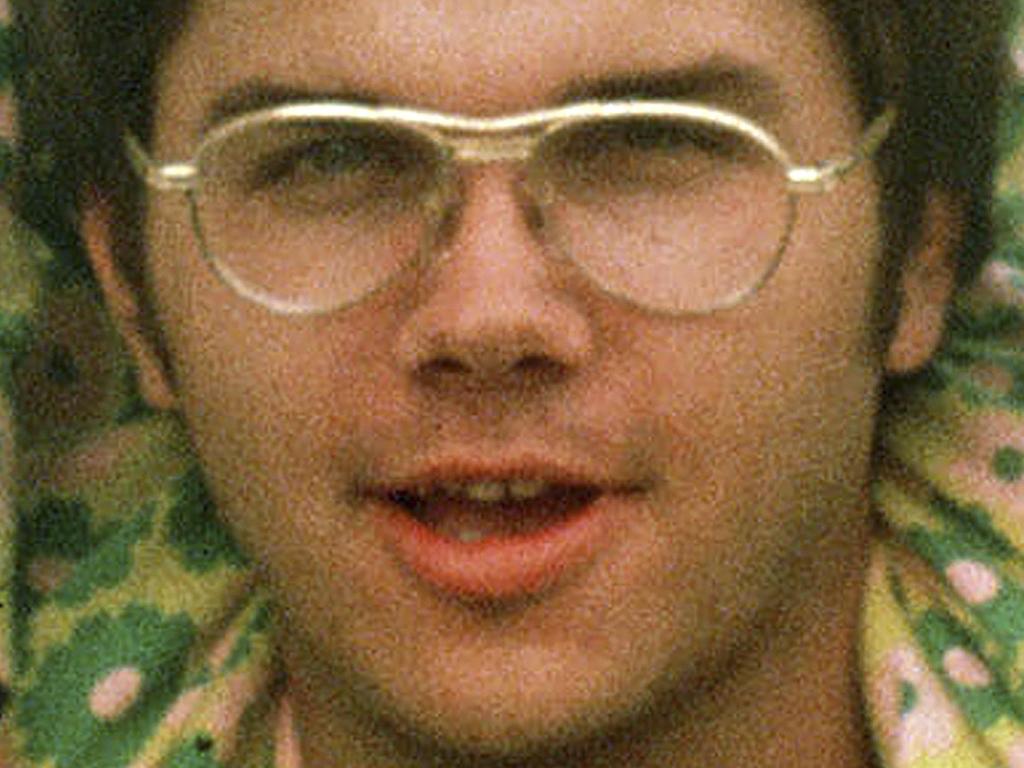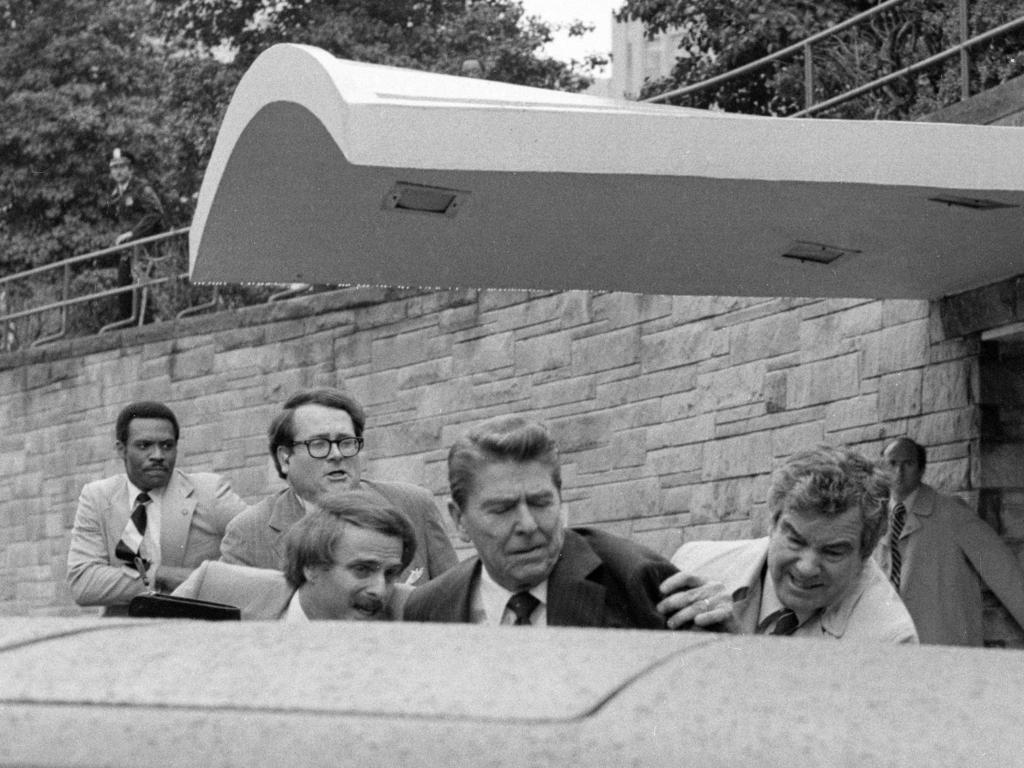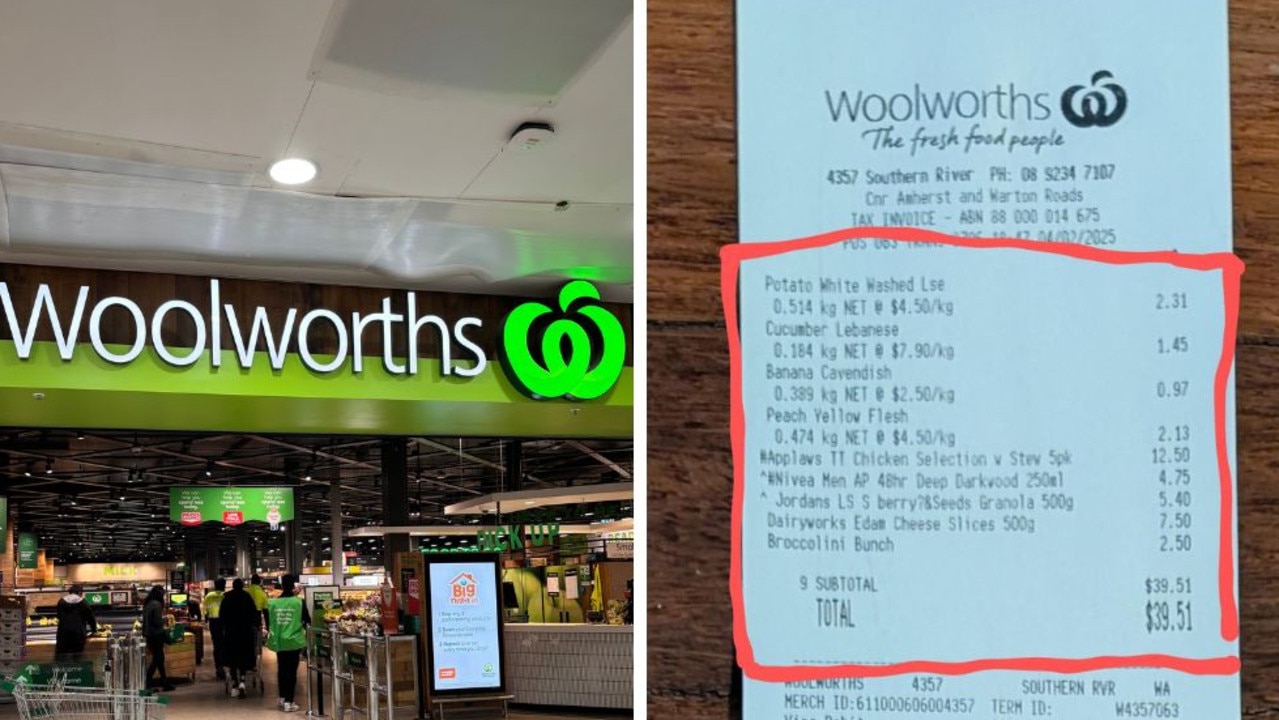‘Shocked to the core’: Murderer’s bizarre act after killing John Lennon
After gunning down one of the world’s greatest musicians, Mark David Chapman sat down and did something that shocked police to their core.
Thirty-nine years ago today, John Lennon was murdered in the archway of the Dakota in New York, the place he and wife Yoko Ono had called home for seven years.
He had met his assassin just hours earlier.
Mark David Chapman was a 25-year-old who was obsessed with Lennon – on his final day of work as a security guard in Honolulu before travelling to New York to commit the murder, he signed his log sheet as “John Lennon” – and had planned his murder for months.
In the morning of December 8, 1980, Chapman stood outside the Dakota Building and waited all day to catch a glimpse of Lennon.
At 5pm, Yoko and Lennon returned from a studio session, and Lennon happily signed a copy of their recent record Double Fantasy for Chapman.

Yoko then entered the Dakota while Lennon returned to the studio. Chapman stashed his signed record in a large planter outside the building and waited for Lennon to return.
At 10.50pm, Lennon finally returned and as he entered the building, Chapman fired five bullets at him, four of which hit him in the back. He was pronounced dead 10 minutes after arriving at the hospital.
When police came to arrest Chapman, he was doing something that shocked officers to their core – calmly sitting outside the Dakota reading a copy of The Catcher In The Rye.
Although Lennon was his target, Chapman’s larger obsession was Holden Caulfield, the disgruntled narrator of JD Salinger’s 1951 novel. Caulfield rallied against “phonies” and saw society as being a broken place where adults lose the innocence they once had as children.
Chapman’s copy of the book, which he was still reading as he was arrested, contained his own handwritten words on the inner cover: “This is my statement.”

WHAT DRIVES A KILLER?
In early February, 1981, Mark David Chapman wrote a statement in ballpoint point on a yellow legal pad and sent it to the New York Times. In all caps, he wrote: “It is my sincere belief that presenting this written statement will not only stimulate the reading of JD Salinger’s The Catcher In The Rye but will also help many to understand what has happened.”
He offers no actual clues as to why the book motivated the murder, ending instead with: “My wish is for all of you to someday read The Catcher In The Rye. All of my efforts will now be devoted toward this goal, for this extraordinary book holds many answers. My true hope is that in wanting to find these answers you will read The Catcher In The Rye. Thank you.”
The statement was signed Mark David Chapman – The Catcher In The Rye

At his trial, when asked if he wished to make a statement, Chapman read a passage from the book, where Holden Caulfield describes a vision he has of thousands of children playing in a field of rye, unknowingly running towards a cliff face. “What I have to do, I have to catch everybody if they start to go over the cliff,” Chapman read to the court.
“I mean if they’re running and they don’t look where they’re going I have to come out from somewhere and catch them. That’s all I’d do all day. I’d just be the catcher in the rye.”
The same year, a grief-stricken Ono released a solo album; the cover featured a photograph of Lennon’s bloodstained glasses.

THE PRESIDENT IS SHOT
Lennon’s murder had ramifications that nobody could have predicted.
Texan John Hinckley Jr. was the 25-year-old son of a wealthy oil merchant who was also the president of philanthropic organisation World Vision.
Hinckley was obsessed with John Lennon and actress Jodie Foster, who he had stalked for a brief period. He believed that Foster and Lennon were linked somehow in life, a bond that was broken with the murder of Lennon.
It goes without saying that these are the thoughts of a disturbed mind.
Hinckley wished to make a grand statement to catch Foster’s attention, and flirted with hijacking an aeroplane or committing suicide in front of her.
Feeling that he needed to become her equal in order to successfully woo her, he decided to enter the history books by killing a President. He followed President Jimmy Carter on the campaign trial for months, before being arrested in Nashville on an unrelated weapons charge.
In the downtime, he returned to Texas and set his sights on the newly-elected Ronald Reagan.
Travelling to Washington, he booked a hotel room and wrote a letter to Foster, in which he references leaving dozens of poems, letters and love messages under the door of her college dorm.
The final paragraph explains his twisted reasoning for the shooting: “I will admit to you that the reason I’m going ahead with this attempt now is because I just cannot wait any longer to impress you.
“I’ve got to do something now to make you understand, in no uncertain terms, that I am doing all of this for your sake! By sacrificing my freedom and possibly my life, I hope to change your mind about me.
“This letter is being written only an hour before I leave for the Hilton Hotel. Jodie, I’m asking you to please look into your heart and at least give me the chance, with this historical deed, to gain your respect and love.”
Two hours later, he milled around the Hilton Hotel, and waited as the President made a speech inside. As Reagan exited the building and walked towards a waiting limousine, he fired six shots at the President, one of which ricocheted off the side of the limo and hit him in the chest.
Nobody was killed, but Reagan and three other men were wounded: a Secret Service agent, a policeman, and White House press secretary.

As Hinckley was led away by police, he asked one of the officers if he thought that evening’s Academy Awards ceremony would be postponed – which it was.
In Hinckley’s hotel room, police officers later found a copy of The Catcher In The Rye along with a cassette tape he had recorded on New Year’s Eve, while drinking peach brandy alone in his room. The rambling message detailed his obsession with both Lennon’s murder, and Foster, and lays out his intentions to make “some kind of statement”.
“I just want to say goodbye to the old year, which was nothing; total misery, total death, John Lennon is dead, the world is over, forget it,” Hinckley says on the disturbing audio recording.
“My life is screwed up. The world is even more screwed up. I don’t know why people want to live. John Lennon is dead. I still think about Jodie (Foster) all the time. That’s all I think about really, that and John Lennon’s death.
“They were sort of binded together before December 8, they been binded together since last summer, really. John and Jodie and now one of ‘em’s dead.”
Elsewhere on the tape he strums a guitar and sings Lennon’s 1971 ode to his wife, Oh Yoko!, substituting Foster’s name for Ono’s. He then talks of suicide.
“I can’t go the whole year 1981, I hate the – I don’t care anything about the decade, the ’80s, or the future or anything because the dream is over as Lennon said 10 years ago, but it’s really over now.’’ The tape ends with his plans of making a suicide pact with Foster.
ANOTHER FAMOUS MURDER INSPIRED BY THE BOOK
Unbelievably, in 1989, The Catcher In The Rye was involved in yet another shooting, the third of the decade with links to the book. Rebecca Schaeffer was the star of frothy CBS sitcom My Sister Sam, which ran from 1986-88 and has since slid into obscurity.
The show initially drew a decent-sized audience, among whom was teenager Robert John Bardo. Bardo became obsessed with Schaeffer, who was two years his senior, and proceeded to write numerous fan letters to her, which were answered with a stock letter and a signed photograph.
Craving a more individualised connection, he attempted in vain to get access to the show’s set to play her songs he had written about their imaginary relationship.

Failing this, he hired a private detective, who used the Department of Motor Vehicles database to procure Schaeffer’s home address.
On July 18, 1989, he knocked on her front door, armed with a copy of The Catcher In The Rye and a handgun. He fired one shot into her chest, killing her, and fled, throwing the book onto a nearby roof. Bardo was found wandering glass-eyed on a freeway exit ramp, where he was arrested.
READING INTO THE BOOK
What is it about The Catcher In The Rye that makes it such an attractive prospect to killers? There is nothing intrinsic in the plot that involves murder, although one brief sequence involves Holden Caulfield fantasising about killing a violent pimp with an automatic pistol.
He also refers to the red shooter’s cap he wears as a “people-shooting hat” and, after seeing the word ‘f**k’ written on a wall, says, “I kept wanting to kill whoever’d written it. I kept picturing myself catching him at it, and how I’d smash his head on the stone steps till he was good and goddamn dead and bloody.”
Holden’s bleak view of the adult world runs throughout the novel; he constantly talks about ‘phonies’, a large group comprised of adults, those involved in the film industry, teachers, sellouts; basically everyone that isn’t a sullen teenager or an innocent child.
It is this inevitable loss of innocence that most rankled Caulfield, the tainting of childhood by the realities of the world.
JD Salinger’s biographer Ian Hamilton explained it as the book “all brooding adolescents had to buy, the indispensable manual from which cool styles of disaffectation could be borrowed”.
Towards the end of the novel, Caulfield briefly gives up hope of fitting into society and plans to live as a recluse. Such alienation would no doubt be relatable to the three shooters that were inspired by the book to carry out dark deeds.
Salinger himself never commented publicly on the spate of murders his greatest work inspired.
Long before the 1980s, Salinger was dismayed by the notoriety of his book, which has been heavily scrutinised, banned in many places, censored heavily in others and derided as being morally rotten. Salinger quickly retreated from public life in the early ’50s and gave his final interview in 1980, before the shootings the new decade would bring.

Mark David Chapman has been incarcerated since 1981 and has unsuccessfully applied for parole 10 times since 2000, the most recent being August, 2018, where a parole board said his release would be “incompatible with the welfare and safety of society”.
Every year, on this day, Yoko places a lit candle in the window of the bedroom they once shared in the Dakota Building, and watches it slowly burn out.
Nathan Jolly is a freelance writer | @nathanjolly



